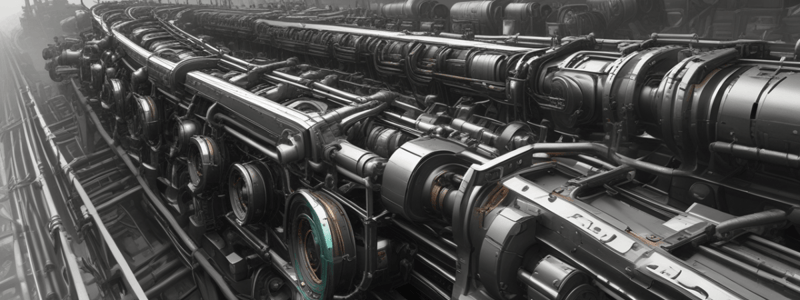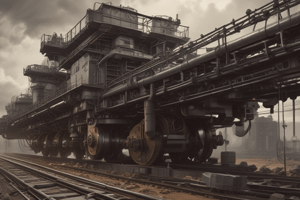Podcast
Questions and Answers
What is the effect of chromium on the growth rate of crystals in steel?
What is the effect of chromium on the growth rate of crystals in steel?
- It has no effect on the growth rate.
- It retards the growth rate.
- It has a varying effect on the growth rate depending on the temperature.
- It accelerates the growth rate. (correct)
What is the effect of adding manganese to carbon steel?
What is the effect of adding manganese to carbon steel?
- It displaces the eutectoid point to the right.
- It displaces the eutectoid point to the left. (correct)
- It increases the critical cooling rate.
- It has no effect on the eutectoid point.
What is the result of adding alloying elements to steel on the transformation rates?
What is the result of adding alloying elements to steel on the transformation rates?
- It has no effect on the critical cooling rate.
- It increases the critical cooling rate.
- It varies depending on the alloying element.
- It reduces the critical cooling rate. (correct)
What is the effect of adding chromium to steel on corrosion resistance?
What is the effect of adding chromium to steel on corrosion resistance?
What is the primary reason for alloying steel?
What is the primary reason for alloying steel?
What is the primary reason why alloys are used for structural materials?
What is the primary reason why alloys are used for structural materials?
What is the approximate percentage of Manganese added to alloy steel?
What is the approximate percentage of Manganese added to alloy steel?
What is the main characteristic of low alloy steels?
What is the main characteristic of low alloy steels?
What is the purpose of adding alloying elements to alloy steel?
What is the purpose of adding alloying elements to alloy steel?
Why are low alloy steels containing nickel particularly suitable for certain applications?
Why are low alloy steels containing nickel particularly suitable for certain applications?
What is the primary reason why high-speed tool steels are able to retain their high hardness at high temperatures?
What is the primary reason why high-speed tool steels are able to retain their high hardness at high temperatures?
Which type of stainless steel contains between 12-18% of chromium and carbon contents ranging from 0.1 to 1.5%?
Which type of stainless steel contains between 12-18% of chromium and carbon contents ranging from 0.1 to 1.5%?
What is the primary advantage of maraging steels?
What is the primary advantage of maraging steels?
Which alloying elements tend to stabilize austenite and increase the range of temperature over which austenite can exist as a stable phase?
Which alloying elements tend to stabilize austenite and increase the range of temperature over which austenite can exist as a stable phase?
What is the primary effect of alloying elements such as chromium, tungsten, vanadium, and molybdenum on the microstructure of steel?
What is the primary effect of alloying elements such as chromium, tungsten, vanadium, and molybdenum on the microstructure of steel?
What is the primary alloying element in stainless steels?
What is the primary alloying element in stainless steels?
What is the typical carbon content in OHNS (O1) tool steels?
What is the typical carbon content in OHNS (O1) tool steels?
What is the purpose of tempering in the heat treatment of OHNS steels?
What is the purpose of tempering in the heat treatment of OHNS steels?
What is a unique property of Hadfield's manganese steel?
What is a unique property of Hadfield's manganese steel?
What is the final step in the heat treatment process for OHNS steels?
What is the final step in the heat treatment process for OHNS steels?
What is a characteristic of martensitic stainless steels?
What is a characteristic of martensitic stainless steels?
Why is chromium essential for stainless steel?
Why is chromium essential for stainless steel?
What is the result of chromium carbide precipitation in stainless steel?
What is the result of chromium carbide precipitation in stainless steel?
What is the purpose of using low-carbon stainless steels in welding?
What is the purpose of using low-carbon stainless steels in welding?
What is the benefit of using stabilized stainless steels in welding?
What is the benefit of using stabilized stainless steels in welding?
What is the purpose of solution annealing in heat treatment?
What is the purpose of solution annealing in heat treatment?
What is the consequence of weld decay on mechanical properties?
What is the consequence of weld decay on mechanical properties?
What is the purpose of using a Strauss test in weld decay detection?
What is the purpose of using a Strauss test in weld decay detection?
What is the primary consequence of weld decay?
What is the primary consequence of weld decay?
What is the benefit of using filler materials that match the base metal composition?
What is the benefit of using filler materials that match the base metal composition?
What is the primary characteristic of high-speed steels?
What is the primary characteristic of high-speed steels?
What is the typical heat treatment process for high-speed steels?
What is the typical heat treatment process for high-speed steels?
What is the primary application of ferritic stainless steels?
What is the primary application of ferritic stainless steels?
What is the primary property of austenitic stainless steels?
What is the primary property of austenitic stainless steels?
What is the primary difference between M2 and T1 high-speed steels?
What is the primary difference between M2 and T1 high-speed steels?
Which element is commonly used in high-strength low-alloy (HSLA) steels?
Which element is commonly used in high-strength low-alloy (HSLA) steels?
What is the primary effect of boron on steel?
What is the primary effect of boron on steel?
Which element is typically considered an impurity in steel, but can improve machinability?
Which element is typically considered an impurity in steel, but can improve machinability?
What is the effect of titanium on the microstructure of steel?
What is the effect of titanium on the microstructure of steel?
Which element is commonly used in stainless steels to improve corrosion resistance?
Which element is commonly used in stainless steels to improve corrosion resistance?
Flashcards are hidden until you start studying
Study Notes
Introduction to Alloy Steels
- Alloy steels are a type of steel that contains other elements besides iron and carbon.
- The addition of other elements improves the properties of steel, making it suitable for various applications.
Classification of Alloy Steels
- Low alloy steels:
- Contain up to 3-4% of one or more alloying elements.
- Similar microstructure to plain carbon steels.
- Used for increasing strength, toughness, and hardenability.
- High alloy steels:
- Possess structures and require heat treatments different from plain carbon steels.
- Examples: high-speed tool steels, stainless steels, and maraging steels.
High-Speed Tool Steels
- Composition: Tungsten, chromium, vanadium, and carbon.
- Properties:
- High hardness and wear resistance.
- Retain hardness at high temperatures.
- Applications:
- Cutting tools: drills, taps, end mills, and saw blades.
Stainless Steels
- Composition: Chromium (min. 12%) and sometimes nickel.
- Properties:
- Corrosion resistance due to chromium oxide film.
- High-temperature resistance.
- Applications:
- Kitchen utensils, medical equipment, and architectural features.
Maraging Steels
- Composition: Nickel, cobalt, and small amounts of titanium and other elements.
- Properties:
- High strength and toughness.
- Low carbon content.
- Applications:
- Aerospace and defense industries.
Effects of Alloying Elements
- Carbide formers: Cr, W, Ti, V, and Mo.
- Austenite stabilizers: Ni, C, and N.
- Ferrite stabilizers: Cr, Mo, Si, Ti, and V.
- Grain refiners: Al, Ti, and Nb.
Specific Alloying Elements
- Carbon (C): increases hardness and strength.
- Chromium (Cr): improves corrosion resistance and hardness.
- Nickel (Ni): improves toughness and corrosion resistance.
- Manganese (Mn): improves strength and deoxidizes the steel.
- Molybdenum (Mo): enhances strength, hardness, and corrosion resistance.
- Vanadium (V): improves strength, toughness, and wear resistance.
Heat Treatment
- Austenitizing: heating to form austenite structure.
- Quenching: rapid cooling to achieve desired properties.
- Tempering: heating to reduce brittleness and improve toughness.
Specific Steel Types
- OHNS (O1) steel: high-speed tool steel with high hardness, toughness, and wear resistance.
- Hadfield's manganese steel: high-manganese steel with high toughness and wear resistance.
- High-speed steel (HSS): used for cutting tools due to high hardness and wear resistance.### Ferritic Stainless Steels
- Magnetic
- Good corrosion resistance, particularly in less severe environments
- Good ductility and formability, but less than austenitic grades
- Lower cost due to lower nickel content
- Limited hardenability, only by cold working
- Applications: automotive parts, kitchen equipment, industrial equipment, and architecture
Austenitic Stainless Steels
- Composition: 16-26% Cr, 6-22% Ni, low C (<0.08%), and other elements like Mn, N, and Mo
- Non-magnetic, but can become slightly magnetic when cold worked
- Excellent corrosion resistance in a wide range of environments
- Good weldability without requiring post-weld heat treatment
- Good toughness and ductility at high and low temperatures
- Hardenable by cold working
- Applications: food and beverage equipment, medical devices, chemical and petrochemical industry, construction, and household items
Martensitic Stainless Steels
- Composition: 11.5-18% Cr, higher C (0.1-1.2%), and sometimes Ni for toughness
- Magnetic
- High strength and hardness, can be significantly hardened by heat treatment
- Moderate corrosion resistance, lower than austenitic and ferritic grades
- Good wear resistance due to high hardness
- Heat treatable to achieve a wide range of hardness and strength levels
- Applications: cutlery and blades, turbine blades and engine parts, valves and pumps, and springs and fasteners
Weld Decay
- Type of intergranular corrosion that occurs in some stainless steels, particularly austenitic grades
- Occurs in the heat-affected zone (HAZ) adjacent to the weld
- Caused by chromium carbide precipitation and chromium depletion
- Prevention methods: using low-carbon grades, stabilized grades, heat treatment, controlled welding techniques, and proper filler materials
- Detection methods: sensitization tests (e.g., Strauss test) and microstructural analysis
- Consequences: inter-granular corrosion, reduced mechanical properties, and premature failure
Studying That Suits You
Use AI to generate personalized quizzes and flashcards to suit your learning preferences.





